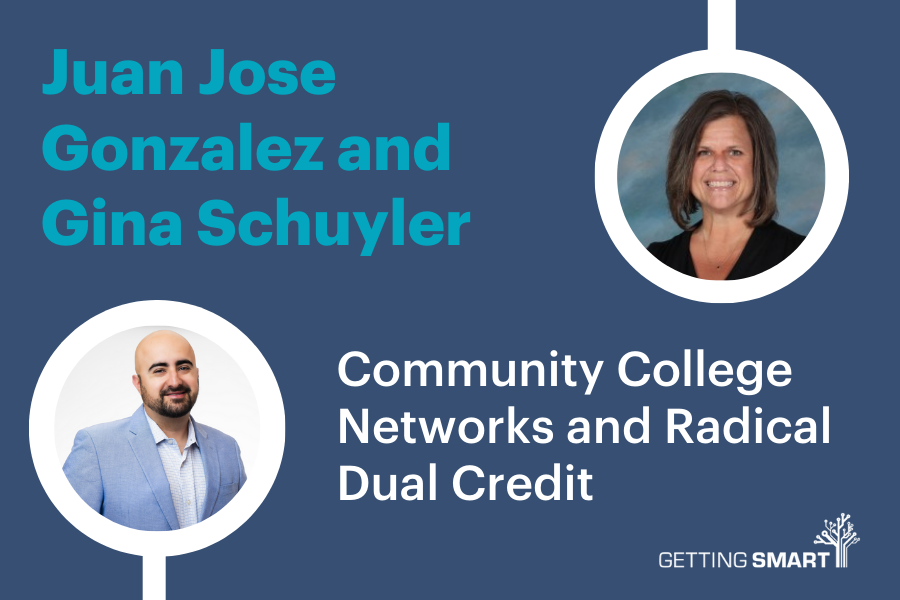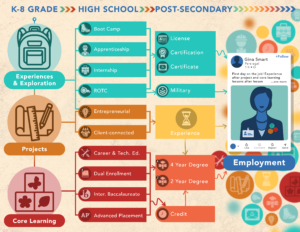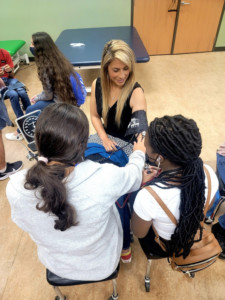Juan Jose Gonzalez and Gina Schuyler on Community College Networks and Radical Dual Credit
Key Points
-
Integrating career and technical education with dual credit courses and work-based learning opportunities ensures students are both college and career-ready.
-
Effective partnerships between K-12 schools, post-secondary institutions, and local industries are crucial for creating equitable and scalable education pathways.

On this episode of the Getting Smart Podcast, Shawnee Caruthers is joined by two of the leaders leaning into this space, Juan Jose Gonzalez, Managing Director of Pathways & Operations at Education Systems Center at Northern Illinois University (EdSystems) and Gina Schuyler, Department Chair of Career and Technical Education at Grayslake Central High School, a partner of EdSystems.
EdSystems is a part of the Accelerate ED initiative, supported by the Bill & Melinda Gates Foundation. Accelerate ED is built on the idea that high schools can provide early access to quality higher education in ways that incorporate work-connected learning and have long-term benefits for students. This initiative helps state- and region-based groups plan and build accelerated pathways between K-12 education, postsecondary education, and careers.
Together, Gonzalez and Schuyler discuss the implementation of Illinois’s Postsecondary Workforce Readiness Act and the College and Career Pathway Endorsement Framework. The conversation highlights the collaboration between K-12 education, post-secondary institutions, and the workforce to create equitable access to high-quality career and technical education (CTE) and dual credit courses. They emphasize the importance of innovation, partnership, and continuous learning to prepare students for both college and careers and showcase the successful integration of these pathways in Illinois schools.
Juan Jose Gonzalez
Juan Jose Gonzalez is the Managing Director of Pathways & Operations at Education Systems Center at Northern Illinois University where he is heavily involved in implementing Illinois’ Postsecondary Workforce Readiness Act, State Perkins V Plan, College and Career Pathways Endorsements framework, and in developing industry-specific pathways in school districts and communities throughout the state.
Juan Jose began his career as an immigration rights organizer for the Illinois Coalition for Immigrant and Refugee Rights, where he mobilized immigrant citizens to vote and lobby at the state and federal levels for better immigration policy. He then served as the Chicago director for Stand for Children Illinois, leading regional advocacy and policy efforts. Following, he was the director of youth and education policy for the City of Chicago Mayor’s office under Mayor Rahm Emanuel, managing a portfolio that included elementary and secondary education policy, college access, summer employment, and out-of-school time opportunities.
Juan Jose received his Bachelor of Arts at Princeton University and a Master of Public Policy from the University of Chicago Harris School. Since 2018, Juan Jose has volunteered as a student mentor with Chicago’s I-Mentor program at Phoenix Military Academy, supporting Chicago students in the college application and transition process. He is an elected parent member of a Chicago Public Schools Local School Council and previously served as an elected community member and council secretary.
Gina Schuyler
Gina Schuyler is an accomplished education professional with over 26 years of experience in Career and Technical Education (CTE). She serves as the Department Chair of CTE at Grayslake Central High School in Grayslake, Illinois. In her role, Gina has been instrumental in pioneering innovative CTE programs and integrating dual credit opportunities for students.
Links:
Outline
- Introduction to Career and Technical Education Advocacy
- Exploring the Impact of EdSystems and Partnerships
- Strategies and Successes in Illinois’ Education and Workforce Development
- Navigating the Dual Credit Landscape in Illinois
- Looking Ahead: The Future of College Credit Education in Illinois
Introduction to Career and Technical Education Advocacy
Shawnee Caruthers: You’re listening to the Getting Smart Podcast. I’m Shawnee Caruthers. If you’ve ever tuned into a Getting Smart Podcast, you may have heard me say that career and technical education is my jam. I’m a longtime advocate for all learners having experiences that teach new skills, explore possible careers, and build their confidence and sense of belonging.
I’ve seen firsthand how lives are changed when given access to workforce opportunities. Utilizing career and technical education as one vehicle, systems across the country are doing the critical work necessary to build stronger connections between K-12 education, post-secondary institutions, and the workforce.
By engaging in continuous learning and discussion around this work, learners will be more successful, learning environments will become more equitable, and the impact becomes more scalable. Today, I’m joined by two of the leaders leaning into this space: Juan Jose Gonzalez, Managing Director of Pathways and Operations at Education Systems Center at Northern Illinois University, also known as EdSystems, and Gina Schuyler, Department Chair of Career and Technical Education at Grayslake Central High School, a partner of EdSystems.
EdSystems is heavily involved in implementing Illinois’s Post-Secondary Workforce Readiness Act, the State Perkins V Plan, the College and Career Pathways Endorsement Framework, and developing industry-specific pathways in school districts and communities throughout the state. EdSystems is also part of the Illinois cohort of the Accelerate ED initiative supported by the Bill and Melinda Gates Foundation. Accelerate ED is built on the idea that high schools can provide early access to quality higher education in ways that incorporate work-connected learning and have long-term benefits for students. This initiative helps state-based groups plan and build accelerated pathways between K-12 education, post-secondary education, and careers. Welcome, team. How are you?
Juan Jose Gonzalez: How are you? Thank you.
Shawnee Caruthers: I’m doing well. Welcome to the podcast. We’re really interested to hear about all the great work that’s happening in Illinois, and it’s always nice to have a partner in the school district come on together to talk about the well-rounded services that you’re providing for students.
Exploring the Impact of EdSystems and Partnerships
Juan, I’ll start with you. I would love to learn a little bit more about EdSystems and your background. Can you describe what is the core mission and vision of EdSystems, and how do those align with your personal values?
Juan Jose Gonzalez: Yeah, so the mission of EdSystems is to shape and strengthen the education and workforce systems to advance equity and prepare more learners for careers and lives in the global economy. We’re based out of a state university here in Illinois, and we work hard to collaborate with regional and state institutions to provide better education and workforce systems.
I’ve been involved in education policy and advocacy for about 14 years now. It’s been a central part of my career. I’ve been both a municipal administrator and a budgeter and financer, as well as an education advocate trying to convince large systems to shift. It’s been a central part of my career and something I really value as someone who grew up in a public high school, struggled with college selection, and as a child of first-generation immigrants who really struggled to navigate the educational system here in this country. So, it’s been a pleasure to work with partner school districts and to inform how policies get made here in Illinois.
Shawnee Caruthers: Juan described his experience in public education working at Grayslake Central High School. I’m sure a lot of that probably resonates with you and what you may or may not see with your students. Can you tell us a little bit about Grayslake Central High School and why working with EdSystems is really critical to the work that you’re doing?
Gina Schuyler: Definitely. Grayslake District 127 has two high schools, Grayslake Central and Grayslake North, both integral in the career pathway endorsement process. Juan has been an advocate for our school. He’s allowed us to be innovative at a time when, having been in CTE (Career and Technical Education) for 26 years, we had to be the loud voices to ensure that students, parents, and stakeholders knew about what career and technical education is. Partnerships with EdSystems and Juan, along with the timing of the CCPE in Illinois, have been a perfect marriage where school systems are shifting their dynamics to be more pathway-focused. Our visions, values, and initiatives mirror each other’s, allowing us to succeed in our endeavors, goals, and values.
Strategies and Successes in Illinois’ Education and Workforce Development
Shawnee Caruthers: Yeah, I love that you’re talking about being a cheerleader for CTE because sometimes you do have to help your community understand the value, and there are lots of different strategies to make that work. Juan, as we think about some of the key strategies you employ in your work to promote education and workforce readiness, what are some of the strategies used in Illinois?
Juan Jose Gonzalez: We have three buckets of work that we focus on. First is the development of college and career pathways in Illinois, not only CTE systems but also more robust and advanced pathways. We focus on bridges to post-secondary, including dual credit, early college policy and implementation, college and career readiness, work-based learning, and the transition to post-secondary through transitional instruction. Lastly, we care about state longitudinal data systems and the use of data for evaluation. We use these three buckets at three different levels: partnering with state agencies, working regionally with local communities, and piloting innovations to inform state-level work.
Shawnee Caruthers: And Gina, that convening of intermediaries from state and regional levels to workforce, what does that mean for you in the work that you’re doing and the impact you’re trying to make?
Gina Schuyler: Correct. We’ve seen a huge shift where discussions were once only college-related for students. Now, education past high school can look like various things, such as entering the workforce with certifications or earning dual credit, providing significant savings for families. This partnership allows students to be more informed about their options, moving from blind post-secondary education choices to informed decisions. It brings together all the components Juan mentioned, giving students and stakeholders a comprehensive understanding.
Shawnee Caruthers: Juan, as we think about the experiences, because that was among the many things Gina said that stood out to me, and I know that is just one of the values of career and technical education. How is EdSystems promoting or strengthening pathway progressions?
Juan Jose Gonzalez: EdSystems acts as an intermediary organization within a state policy framework central to pathways implementation in Illinois. We identify gaps or barriers, pilot solutions with regional teams, and share lessons learned to inform state policy. For example, dual credit implementation might struggle due to a lack of credentialed teachers. We look for innovative solutions, such as virtual opportunities or regional career centers. Our role is to pilot, scale, and facilitate communication and solutions across various educational and workforce systems.
Gina Schuyler: Juan mentioned having an overview of what’s happening in Illinois. Our district’s partnership with EdSystems means he’s able to connect us with initiatives like IT pathways or help other districts by sharing our experiences. It’s like having eagle eyes, putting partners together to replicate best practices across the state for the benefit of all students.
Shawnee Caruthers: Yeah. It sounds like you all have a lot of partners to help inform decisions regarding pathways and beyond. So why IT pathways?
Juan Jose Gonzalez: For the Accelerate ED initiative, we chose to pilot IT pathways due to the sector’s growth and lagging implementation in Illinois. The College Career Pathway Endorsement Framework initially saw health science, manufacturing, and education pathways. IT was the next in-demand sector not yet addressed. IT pathways offer opportunities for virtual learning and innovation, making it a prime candidate for accelerated implementation.
Shawnee Caruthers: And Gina, have you found that to be true for your community in terms of the need for increased IT pathway exposure?
Gina Schuyler: Definitely. We work closely with Lake County Partners and Lake County Workforce to identify needed areas. Health science, manufacturing, and IT are prominent, with IT embedded in the others. With the rise of AI, it was a perfect partnership for our students to access these growing fields.
Navigating the Dual Credit Landscape in Illinois
Shawnee Caruthers: As we think about the state dual credit policy and its impact, how has the implementation of the Illinois Post-Secondary and Workforce Readiness Act impacted the accessibility of college credit courses for students?
Juan Jose Gonzalez: The Post-Secondary and Workforce Readiness Act, passed in 2016, has four key components. Relevant to this discussion is the implementation of transitional instruction—college readiness courses in math and English that place students into college-ready coursework. Another component is the College and Career Pathway Endorsement Framework, defining a pathway as two years of coursework, including college credit, work-based learning activities, and career readiness in math and English. This endorsement on a diploma signifies a student’s completion of this structured pathway.
Initially, only a few school districts adopted this framework. In 2022, an amendment required all school districts to implement at least one pathway. Consequently, we now see about 280 school districts implementing pathways. This framework has increased access to career-focused dual credit coursework, fostering more collaboration between high schools and community colleges. It encourages a marriage of systems that might otherwise only be dating.
Shawnee Caruthers: I love that analogy! And Gina, can you articulate what dual credit looks like in CTE in your space and the impact of increased readiness in math and English?
Gina Schuyler: Grayslake District 127 was a pilot district for the CCPE process, starting in 2019-2020 during the pandemic. When I arrived, we had no early college credit in CTE. Now, we have dual credit in several areas. This has diversified students’ portfolios, offering more than just AP courses. It’s created equitable access to early college credit, benefiting students and families with a significant return on investment. Career exploration and internship coordinators now help coordinate work-based learning and team challenges, reshaping the high school education framework.
Shawnee Caruthers: Juan, congratulations on the systemic work you’re doing. One challenge you mentioned is ensuring parents are informed. How will changes in pathways influence the scale and scope of college credit courses offered? What challenges and opportunities do you foresee, especially regarding mixed student eligibility courses?
Juan Jose Gonzalez: In terms of scale and scope, the pathway endorsement framework, along with innovations in the state’s dual credit quality act, has raised questions about teacher credentialing and student eligibility for college-level courses. We aim to ensure equity in course access, making sure benchmarks aren’t unnecessarily high. For example, medical terminology doesn’t require college-level junior standing. By focusing on equity and access, we see increased dual credit implementation. Research shows that dual credit access has doubled in recent years, though disparities remain. We focus on supporting districts with high racial minorities, low-income status, or rural locations to scale dual credit implementation equitably.
Shawnee Caruthers: That’s a great approach. Gina, are you finding a shift from more AP to dual credit in your space?
Gina Schuyler: Yes, though AP remains strong, dual credit is now at the table. We have dual credit in math, English, and science. The Dual Credit Quality Act has opened discussions and created equitable access. In Lake County, our dual credit partner has great communication, dedicated roles, and collaboration with EdSystems. This helps highlight curriculum gaps, creating plans to ensure equitable access to dual credit.
Juan Jose Gonzalez: Traditionally, public high school systems had distinct tracks for college-bound and workforce-bound students. The pathway frameworks in Illinois raise the floor for career-focused students, making them college and career-ready simultaneously. This inclusion of dual credit in CTE sequences shows students they can achieve both career readiness and college credit, enhancing their career trajectories.
Gina Schuyler: It allows students who might not have considered post-secondary education to succeed in their first college class, building confidence. We celebrate their successes and help them identify skills and interests, even if they discover a field isn’t for them. It’s about transferable skills and continuous learning.
Shawnee Caruthers: How will this be measured? What does impact measurement look like for students transitioning from high school to beyond?
Juan Jose Gonzalez: Several metrics are in place. The state tracks students earning the college career pathway endorsement on their diplomas. In 2023, the number of students increased from 50 in 2020 to 1,000. I expect this to double as more districts implement the pathway endorsement framework. The Illinois school report card now tracks CTE students’ graduation rates, post-secondary enrollment rates, and dual credit completion rates. We’ve seen a doubling of dual credit and AP completion rates in the last five years. EdSystems also has a longitudinal data system with data-sharing agreements to track students’ post-secondary success and the impact of their high school experiences.
Shawnee Caruthers: Gina, how does this program specifically benefit your IT pathways?
Gina Schuyler: The data shared with EdSystems has led to a deep dive into our IT pathways. We discovered we had more than one pathway, providing additional on and off ramps for students. It has offered access to equipment and work-based learning opportunities that might otherwise be unaffordable. Partnering with other districts to share best practices has been invaluable. The unrestricted innovation funds from EdSystems have allowed us to incentivize student engagement in career interest exploration, creating a snowball effect of interest and conversation.
Shawnee Caruthers: How do you get educators and leadership to adapt to these legislative changes?
Juan Jose Gonzalez: It can be tricky. Sometimes it’s about weathering storms and waiting for things to normalize. EdSystems uses a carrot approach, providing innovation funds to districts willing to try new things. Once we have proof points of success, we systematize good baseline implementations across different districts. Giving regional partners a voice in advising policy increases their buy-in. However, not everyone will always be happy, and that’s okay. We continue to work together and find common ground.
Gina Schuyler: We used EdSystems funds to incentivize students to identify their career interests using platforms like YouScience and Schoolinks. Small rewards created conversations about pathways and interests, demonstrating the power of unrestricted funds for innovation.
The Future of College Credit Education in Illinois
Shawnee Caruthers: As you both think about the future of college credit education in Illinois, what do you see?
Juan Jose Gonzalez: Illinois is unique with two models: traditional CTE and high-dosage college credit models. The pathway endorsement framework creates an attainable benchmark of college credit for as many students as possible. Access to six hours of college credit and the encouragement of college credit in math and English sets students up for success. This approach doesn’t restrict high-dosage models but offers an equilibrium that many districts can reasonably attain for a significant portion of their students.
Gina Schuyler: I see a huge shift, removing silos and creating more cross-curricular pathways in high schools. There will be a better return on investment and a stronger pipeline entering the workforce. The CCPE helps businesses engage with schools by showing that students are receiving college-level courses and work-based learning opportunities. This changes the landscape of education and workforce engagement.
Shawnee Caruthers: I appreciate the foundation you’re setting in Illinois and the intentional buy-in at all levels, ensuring equitable access to dual credit and beyond. Great job, and thank you for stopping by Getting Smart today.





0 Comments
Leave a Comment
Your email address will not be published. All fields are required.